From Tuesday, May 21 to Friday, May 24, follow the University of Iowa's 2013 Faculty Engagement Corps tour of northwest Iowa, including Orange City, Okoboji, Estherville, Spencer, Lester, Le Mars, Sioux City, Sergeant Bluff, and Storm Lake. You can also look for updates during the week on Facebook and Twitter (#UIEngaged), and photos from the trip on Flickr.
May 25, 2013: Growth and diversity present new challenges for K-12 schools
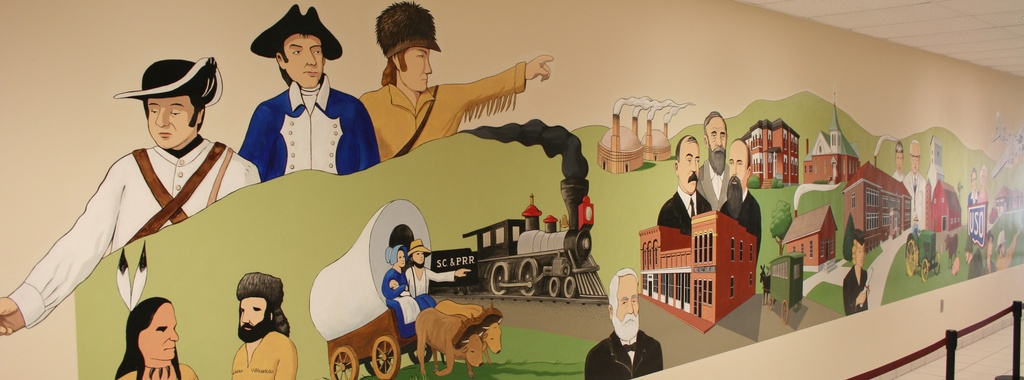
About nine miles south of Sioux City is the town of Sergeant Bluff and the cluster of buildings that comprise the Sergeant Bluff-Luton school district. On Friday, the last day of the University of Iowa Faculty Engagement Corps trip in northwest Iowa, the UI visitors stopped by to hear from pupils, teachers and administrators from pre-school through high school.
Sergeant Bluff-Luton school appears to benefit from being a bedroom community to Sioux City, and an area that may be poised for explosive growth, due to the expected influx of families from the likely expansion of a major fertilizer manufacturer in town. As Jason Klingensmith, the high school’s principal, says, “We are a growing community in a growing district.”
Traveling with colleagues as part of the Faculty Engagement Corps “brings home what a tremendous amount of talent and caring intellectuals who want to connect with people who are very different from themselves. I think it’s good for the university and for all of us.”
Sally Scott,assistant research scientist at the UI Public Policy Center
Growth is good, to be sure, but it eventually will strain capacity, and such is the case with the school district. There are 300 children in the elementary school, grades three through five, served by 16 classroom teachers, says Jenni McCrory, school principal. Yet, despite a clean, modern building that opened in 2000, the elementary school is at capacity for space and students, she said, with two teachers already sharing classrooms. The high school also is full, with its 470 students just 30 shy of capacity. Assuming the fertilizer company expansion does come to fruition, push likely will come to shove in the district.
Another challenge lies in educating the children. McCrory says around one in 10 pupils lack “intrinsic motivation,” or the will to excel academically, and that lackadaisical attitude to schoolwork goes unchallenged by parents. Many of these children also are hooked on video games, so-called “gamer kids,” as McCrory describes them, bent more on the instant gratification of succeeding in a game than the delayed satisfaction of succeeding in school.
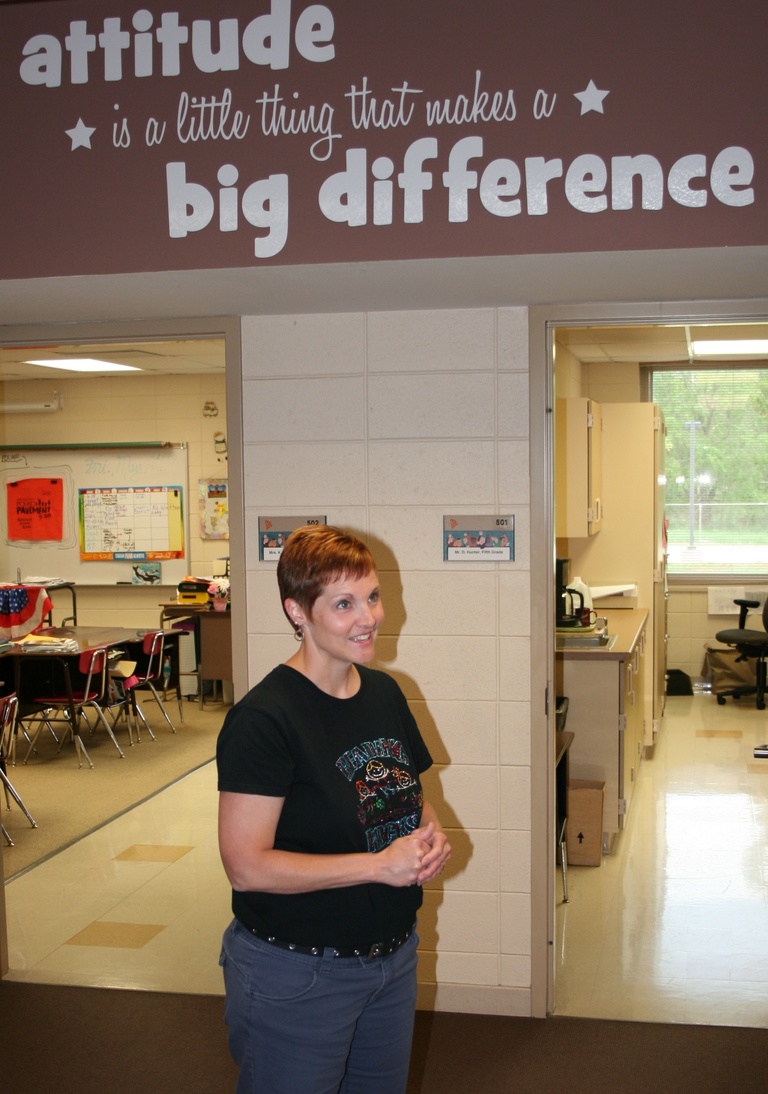
“Education is not as important as it should be,” says McCrory, who’s been the elementary school principal for 10 years.
Another obstacle, common to schools at all levels nationwide, lies in keeping current with technology. Sergeant Bluff-Luton Elementary School has 260 computer stations for its students. Add in a few dozen laptops, and the student to computer ratio is essentially 1:1.
Small town libraries in Iowa are dealing with a different set of issues. At the library in Storm Lake, the last stop on the UI faculty tour, director Misty Gray says she and her staff serve a community of about 11,000 where 30 languages and dialects are spoken in the schools. Many of the immigrant residents have come from Central and South America to work in the two hog and turkey processing plants in town, and the library has a full-time Spanish-speaking clerk to work with them. The Hispanic population in town includes undocumented workers, and not just a few; Gray says she and her colleagues see them frequently, and all they require to check out a book or use the library’s services is a government-issued identification: U.S. or foreign. Oh, and a picture, too, and you can make a funny face if you want.
“We’re not the INS,” Gray stresses. “We don’t care whether you’re legal. We just want you to check out and return stuff.”

After four days of listening and learning, UI faculty were experiencing a range of emotions and hatching many ideas. Mark Isham, who teaches in the English department and at the College of Engineering, says the interaction with the Native American tribes in the Sioux City area had left an indelible impression. “It was a unique experience,” he says. “Culturally, we don’t have that many encounters with Native Americans, and they had a chance to speak from their hearts about their life experiences.”
Sally Scott likewise was moved by the Native American tribes. The assistant research scientist at the Public Policy Center also highlighted what she learned about the wind-energy technician curriculum at Iowa Lakes Community College in Estherville. The associate degree program, which Iowa Lakes officials say is the first of its kind established in the United States, gives Iowans a shot at high-paying, long-lasting employment in a sector that can be sustainable and is environmentally benign, she noted. Compare that to the gold rush in natural gas extraction through hydraulic fracturing and the environmental scars it is leaving, and “the path that Iowa is taking is much more promising,” she says.
Aside from meeting dozens of people in at least a dozen stops, Scott and others say they also appreciated meeting each other. Four days on the road together spawns personal and professional relationships far deeper than fleeting or chance encounters on campus. “It brings home what a tremendous amount of talent and caring intellectuals who want to connect with people who are very different from themselves,” Scott says. “I think it’s good for the university and for all of us.”
May 24, 2013: Farming smarter, preserving tradition and living healthier
In 1888, a German immigrant named August Mogler and his wife, Mary, bought 165 acres near Lester, Iowa, to grow crops. One-hundred and thirty five years later, Mogler Farm LLC is a 2,500-acre farming, cattle, pig, and grain storage and sales operation faithfully sustaining six generations of the family.
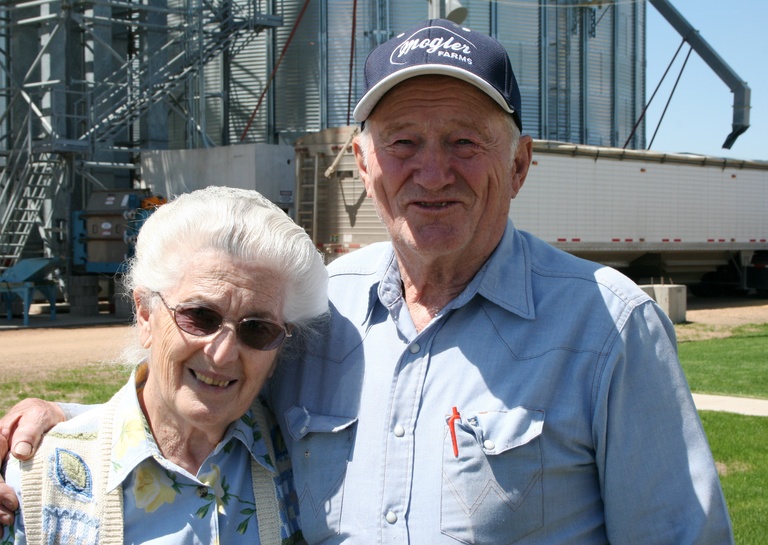
“We’ve had a good life,” says Lollie Mogler, who along with her 81-year-old husband, Howard, head the Mogler business, “and we’re proud to have passed it on to our children.”
Succession. Diversification. Productivity. Efficiency. Sustainability. Competition. Success. Those were many of the words that University of Iowa faculty heard from various members of the Mogler family as they described their multifaceted enterprise in a lunchtime visit on Thursday to the farm, located in the far northwest corner of Iowa.
Rodney Mogler, one of four brothers involved in the business, runs the agronomy side. He says the family takes its role seriously to produce as much food for a rapidly growing world in as humane and environmentally friendly method as possible. For crops, that means terracing at the fields’ edges to prevent phosphorous runoff into waterways. For pigs, that means ventilating the buildings to maintain the temperature between 68 and 72 degrees Fahrenheit. For cattle, it means rubberized flooring for comfort and to reduce foot problems.
“We need to produce twice as much food by 2040 (as we do currently),” says Mogler, wearing a Mogler Farms tan golf shirt with his first name stitched in cursive on the front. “We ain’t got another planet Earth to do it. So, it’s gotta come from here.”
The crop growing operation is based on science and is predicated on precision. The tractor cabs are equipped with GPS devices and 11 monitors (including iPads) to set the rows and guide the machine’s progress so expertly that the driver can set it on autopilot. Each seed tube on a planter spits out 11 seeds a second, each spread exactly 9 inches apart. The result: 38,000 seeds an acre, producing roughly 350,000 bushels of corn a year (soybeans are also planted), or the equivalent of 13 million boxes of corn flakes.
The hog operation came later and has grown to 950 sows that, when birthing, are cared for around the clock. They yield 24,000 hogs ready for market annually.
By expanding into hogs, cattle and, most recently, grain storage, the family is trying to hedge against downturns in any one commodity, and create job opportunities and added value for younger generations where land is expensive and a business model is traditionally described as capital intensive and cash poor.
“For (our children and grandchildren) to think about farming,” says a brother, Dwight Mogler, “it would be nearly impossible today.”
After a quick stop at the Blue Bunny ice cream parlor in Le Mars (which bills itself as “the ice cream capital of the world”), the UI group headed to Sioux City. In a converted cinderblock garage on the edge of downtown, the scent of burning sage filled the air and a circle of Native American men beat drums and sang traditional songs as the UI guests filed in.
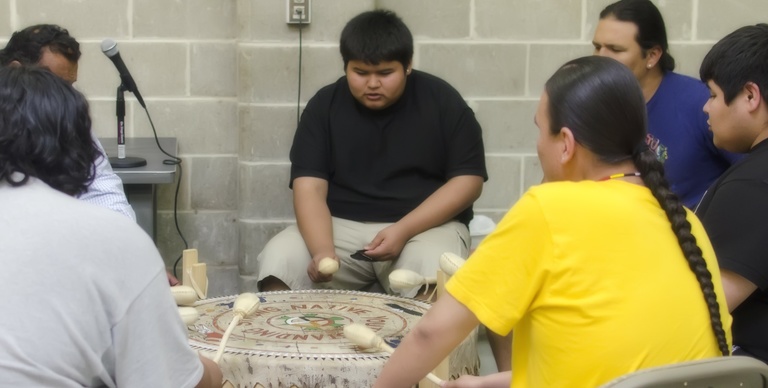
The reason for the gathering was to mark the accomplishment of Native Youth Standing Strong, an initiative begun by local tribal leaders in Sioux City and its immediate environs to educate Native American youth of their ancestors’ rich culture, language, music, and spiritual heritage.
Manape LaMere is one of the drummers and has assumed a mentoring role for Native American youth since his release from prison two years ago.
“Mentoring is about living lives in a good way,” he says. “We talk about these things with the kids. How we overcome things.”
The meeting included a parade of speakers that was part testimonial, part group therapy, part politics, part educational, part leadership and part telling stories. Together, it was about fellowship and sharing a common cause, culture, and mission.
“We’re a no-nonsense group … and we want to make ourselves well,” says Frank LaMere , a member of the Ho-Chunk (Winnebago) tribe and one of the leaders in the Native American community in Sioux City.
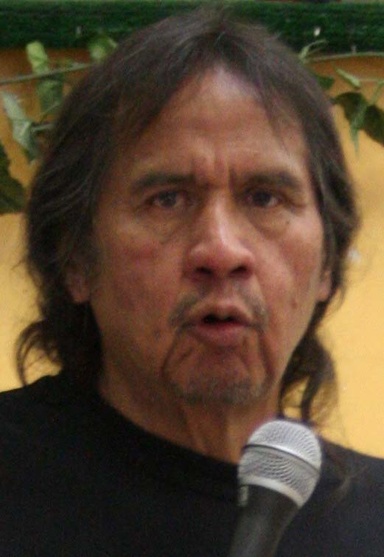
Another initiative was on display in Spencer, the first stop of the day. The picturesque town of about 11,000 was recently named a Blue Zones community for its effort to encourage residents to live happier, healthier and longer lives. After a presentation in the City Council chambers, a surprise awaited: The Blue Zones’ mascot, “Super Blue” strode into the room to the strains of Gloria Estefan’s late 1980s hit Get on Your Feet. Initially stunned by the appearance, the UI faculty responded to Super Blue’s entreaties to move and groove, rising to their feet and pumping and waving their arms and dancing to the Latin beat.
“We just thought it was so appropriate, because it’s about moving and taking action,” says Sheriffa Jones, a Blue Zones Project coordinator who lives in the town.
UI faculty came away impressed. “It’s a lifestyle modification that people can make,” says Mike Farley, assistant professor at the College of Pharmacy who grew up in Indianola . “It’s the same thing we tell individuals who have health problems, and they need to make lifestyle changes. And, they’re doing it at a community level.”
Spencer expects to be certified as a Blue Zones community later this year. To reach that distinction, it — along with other communities, such as Iowa City, which recently enrolled in Blue Zones — must satisfy nine criteria ranging from urging residents to undergo daily physical activity and socialize with family and neighbors to adding healthier food choices at grocery stores and restaurants. Each town in the Blue Zones program must get pledges from 20 percent of the residents and businesses to meet at least one of the criteria.
Editor's note: Sioux City's Channel 9 TV news crew caught up with the Faculty Engagement Corps Thursday. Watch a clip of the report here.
May 23, 2013: Forging personal and professional connections
Dave Kerr stood up during lunch at the Great Lakes Rotary Club, because he wanted to thank the University of Iowa.
Around Thanksgiving in 2006, Kerr, who lives in Spirit Lake, noticed that he had a welt on his face about half the size of his thumb, lodged just beneath the skin. Told that he had a rare disease called Merkel cell, Kerr sought treatment at UI Hospitals and Clinics in Iowa City, although it was more than five hours away.
“I decided this was the best course of action,” he says, “because they wanted to save my life.”
For more than two months, Kerr endured daily, 45-minute radiation sessions at UI Hospitals and Clinics, cared for by staff. He has been cancer free since.
“I just found everybody I met was so professional, so caring, so concerned for me as a human being,” the 64-year-old says. “It was a marvelous place to be.”
Kerr’s testimonial came Wednesday, on the second full day of the UI’s Faculty Engagement Corps trip to northwest Iowa. That morning, the 18 faculty representing disciplines from art to pharmacy met with faculty from Northwestern College, a Christian liberal-arts institution in Orange City. The discussions touched upon the similarities and differences between the schools and opportunities for partnerships. One idea proposed by David Dick, in radiology, is for faculty to come to Northwestern College for a day-long series of guest lectures. Another was to look into joint summer camps, student internships and student exchanges for research.
In all, faculty at both institutions easily found common ground, as one from Northwestern College put it, “Our challenge is to help these students become world citizens.”
Common bread—or rather, salmon and rice—was broken at the rotary club lunch in Okoboji. Rotarians had several questions for their UI guests, from the threat from viruses in the news to the importance of music in helping older people with Alzheimer’s or children with autism. Then Dawn Heaton, a real estate agent in Spencer, appealed to the group at large for assistance in guiding the educational pursuits for a son, whom she described as “thinking out of the box.” To that, Anne Wallace had an answer. The clinical associate professor in communications sciences and disorders told Heaton that she, too, had a child who marched to a different academic beat. Later, geosciences associate professor David Peate spoke with Heaton and offered to further her son’s interest in geology.
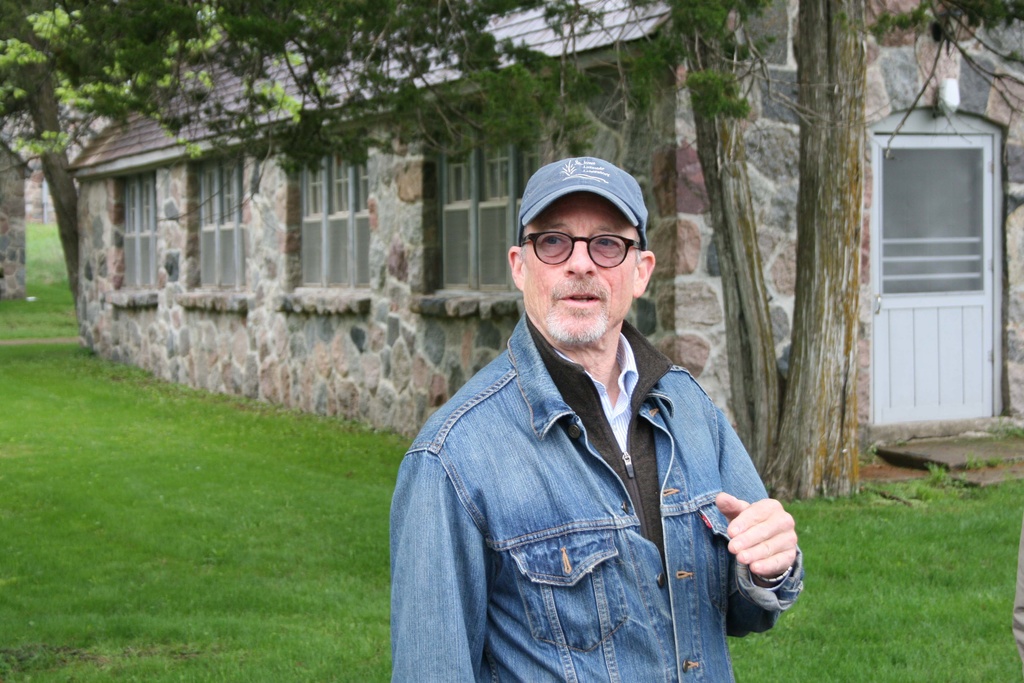
The UI group then toured the Iowa Lakeside Laboratory, a 147-acre research and educational campus alongside West Okoboji Lake run by the Iowa Board of Regents. Lakeside’s academic and research director, UI biology professor Steve Hendrix, said the complex supports up to 50 students at one time, whose profiles range from artists in residence to diatom research.
About those diatoms: They’re single-celled organisms that are an essential link in the oceanic food chain and such prolific photosynthetic agents that they’re an excellent barometer of the health of oceans, rivers and lakes. Each year, Lakeside hosts a month-long class devoted exclusively to diatoms, and that draws graduate students and higher-education faculty from around the world. It’s considered one of the few places where you can get full immersion in all things diatomorama.
“You can’t pull this class off at one university,” says the course’s instructor, Mark Edlund, senior scientist at the St. Croix Watershed Research Station in Minnesota.
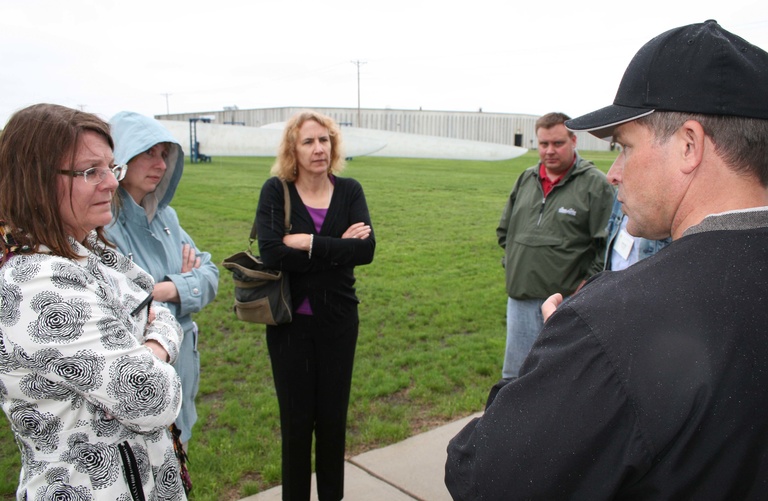
The last stop on Wednesday’s tour was at Iowa Lakes Community College in Estherville, at a modern building dedicated solely to the school’s wind-energy program. The wind-energy associate degree curriculum at Iowa Lakes, begun in 2004 and the first of its kind in the United States, has a natural appeal in the Hawkeye State and with the UI. Iowa is ranked second nationally in the percentage of electricity derived from wind (behind South Dakota) and second in wind energy production (behind Texas), according to the American Wind Energy Association. The state also is home to several manufacturers for wind turbines and parts.
And, UI researchers are studying turbine design and wind dynamics through its involvement in the $22 million National Science Foundation Experimental Program to Stimulate Competitive Research.
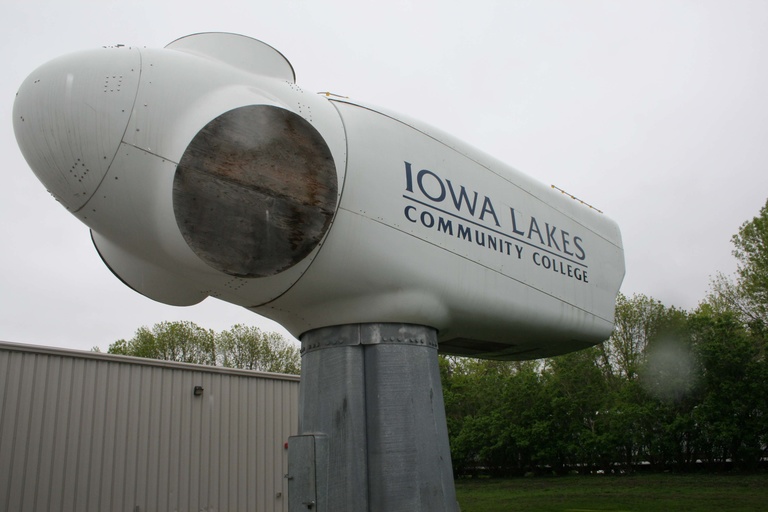
The tour included a look at a demonstration 1.65 megawatt turbine on the Iowa Lakes campus and peering inside the nacelle, the turbine’s housing that’s the size of a school bus. The views made quite the impression on public health associate professor Diane Rohlman, who announced she wants to return with colleagues to climb a turbine and discuss potential collaboration with occupational safety, ergonomics, and confined spaces.
May 22, 2013: Homecoming
Leighton Smith is going home again.
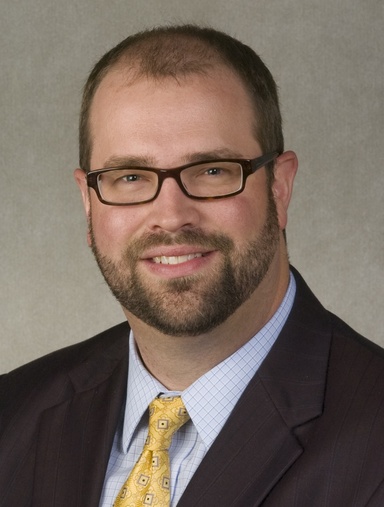
Well, sort of. The University of Iowa adjunct professor in the Tippie College of Business who hails from northwest Iowa attended a wedding in Okoboji last week. And, he returns frequently to visit his parents and his in-laws, both of whom live in this bucolic corner of the Hawkeye State.
Yet, despite the regular trips home, Smith’s sojourn this week with the UI’s Faculty Engagement Corps to northwest Iowa will have a different feel. Rather than visiting with family and friends, he and more than a dozen UI faculty will meet with educators, community leaders, health-care professionals, business people, farmers, renewable energy enthusiasts and others in several cities and towns to hear from them and to find out how the university can further engage with them. This is the eighth such trip for the corps, sponsored by the Office of the Provost.
This is Smith’s maiden voyage with the corps. Yet he comes with a deep reservoir of knowledge about the residents, communities and issues that permeate northwest Iowa. He grew up on a family farm on C66 just north of Holstein, on a road known to locals as “the Hawkeye.” He went to school in the former Galva-Holstein school district (now called Ridge View). His parents met when his father sauntered into the Cherokee State Bank in Cherokee, where his mother worked as a teller. (“Biggest withdrawal I ever made there,” Smith recalls his dad saying proudly.)
Want more? Smith’s wife, Sarah, is from Alta, also in northwest Iowa, and a hub for wind energy, one of Iowa’s lesser known calling cards. (The Hawkeye State ranks second nationally in wind-energy production, according to the American Wind Energy Association.)
“I’m very proud of where I’m from, and I want to learn more when I can,” says Smith, who earned his business and law degrees from the UI and joined the business faculty last year. “I like to jump into things, and it just seemed like a cool opportunity.”
Smith says he expects UI faculty should expect an “engaged citizenry” interested in, among other issues, agriculture and tax implications related to family farms, health care and clinical specialties at the UI Hospitals and Clinics and renewable energy. And, Hawkeye football, even in what may be considered hostile collegiate athletics country.
“I think people are proud of the University of Iowa,” Smith says. “They know that if you go to the UI, you’re perceived as one of the brightest around.”
May 21, 2013: On the road
This eighth annual Faculty Engagement Corps, made up of 20 UI faculty from a range of colleges and disciplines, sets off this afternoon for northwest Iowa. Most of the day will involve travel by bus: five hours and 17 minutes, actually, to cover the 318 miles between Iowa City and Sioux Center.
After overnighting, the group’s work will begin in earnest Wednesday. On the itinerary are a higher education “summit” with colleagues at Northwestern College in Orange City, a lunch meeting with the Great Lakes Rotary in Okoboji, a tour of Iowa Lakeside Laboratory, and a discussion about wind energy at Iowa Lakes Community College in Estherville. The day will wrap up with dinner and an overnight in Spencer.
Look for ongoing updates of the trip starting Wednesday. In the meantime, here are two earlier stories that help shed some light on the goals, and benefits, of the Faculty Engagement Corps, which was first funded in 2006 through a Year of Public Engagement grant and now is supported by the Office of the Provost.
- Mark Isham, a professor with a dual appointment in the UI College of Engineering and the College of Liberal Arts and Sciences Department of English, reflects on his experience traveling with the corps to northeast Iowa in 2012: now.uiowa.edu/2012/06/seeing-iowa-many-perspectives.
- In a story from the 2007, when the corps also visited northeast Iowa, participants discuss their meetings with educators, parents and students in Postville to hear about the challenges faced by recent immigrants to the area, as well as communities’ aspirations for economic development and tourism: www.uiowa.edu/~fyi/issues/issues2007_v44/06112007/feature1.html.
Sponsored by the UI Office of the Provost and organized by University Communication and Marketing, the Faculty Engagement Corps is a “listening tour” that gives selected faculty members and administrators the opportunity to spend some time immersed in one region of Iowa;